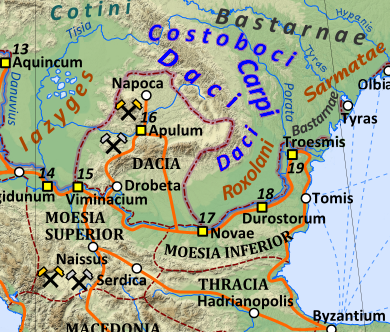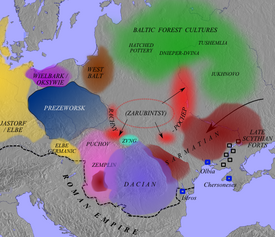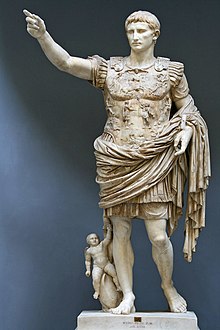Bastarnae
In the mid-3rd century AD, the Bastarnae were part of a Gothic-led grand coalition of lower Danube tribes that repeatedly invaded the Balkan provinces of the Roman Empire.
In one place he described the lands beyond the Rhine and Danube as the home of the Galatian (Celtic) and the Germanic peoples, and beyond these (to the east) were the Bastarnae and their neighbours the Tyregetans "and the River Borysthenes" (Dnieper).
[7] In yet another similar passage he describes the Bastarnae as the most inland (northerly) of the peoples living between the Borysthenes (Dnieper) and the Ister (Lower Danube), and indicates that their neighbours the Tyregetans are closer to the Black Sea.
He confirmed that historically "the Scythians and Bastarnians and Sauromatians on the far side of the river [the Lower Danube] often prevail to the extent that they actually cross over to attack those whom they have already driven out, and some of them remain there, either in the islands or in Thrace".
"[8] In one passage Pliny the Elder located the Bastarnae "and other Germanic peoples" in the lands beyond the Iazyges and Dacians (aversa Basternae tenent aliique inde Germani).
Babeş and Shchukin argue in favour of an origin in eastern Pomerania on the Baltic coast of today's north-west Poland, on the grounds of correspondences in archaeological material, e.g. a Pomeranian-style fibula found in a Poieneşti site in Moldavia,[14] although Batty considers the evidence insufficient.
[24] Much later still, the Greek historian Plutarch (about 46-120 AD), also talking the time of Perseus of Macedon, went further, writing that the Roman consul Hostilius "secretly stirred up the Gauls settled along the Danube, who are called Basternae".
However, some scholars have instead suggested that the name Galicia may derive from its former Celtic inhabitants the Taurisci, Osi, Cotini and Anartes of Slovakia and northern Romania and the Britogalli of the Danube Delta region.
In addition, inscription AE (1905) 14, recording a campaign on the Hungarian Plain by the Augustan-era general Marcus Vinucius (10 BC[28] or 8 BC[29]), also appears to distinguish the Bastarnae from neighbouring Celtic tribes: "Marcus Vinucius... governor of Illyricum, the first [Roman general] to advance across the river Danube, defeated in battle and routed an army of Dacians and Basternae, and subjugated the Cotini, Osi,...[missing tribal name] and Anartii to the power of the emperor Augustus and of the people of Rome.
[41] A complicating factor is that the regions where Bastarnae are attested contained a patchwork of peoples and cultures (Sarmatians, Scythians, Dacians, Thracians, Celts, Germans and others), some sedentary, some nomadic.
[45] Another issue is that the Poieneşti-Lukashevka culture has also been attributed to the Costoboci, a people considered ethnically Dacian by mainstream scholarship, who inhabited northern Moldavia, according to Ptolemy (ca.
They did so at the invitation of their long-time ally, King Philip V of Macedon, a direct descendant of Antigonus, one of the Diadochi, the generals of Alexander the Great who had shared his empire after his death in 323 BC.
[Note 1] After nearly 20 years of slavish adherence to the Roman Senate's dictats, Philip had been goaded by the incessant and devastating raiding of the Dardani, a warlike Illyrian[48] tribe on his northern border, which his treaty-limited army was too small to counter effectively.
Counting on the Bastarnae, with whom he had forged friendly relations, he plotted a strategy to deal with the Dardani and then to regain his lost territories in Greece and his political independence.
[32] Philip's son and successor Perseus, while protesting his loyalty to Rome, deployed his Bastarnae guests in winter quarters in a valley in Dardania, presumably as a prelude to a campaign against the Dardani the following summer.
The Bastarnae easily beat off the attackers, chased them back to their chief town and besieged them, but they were surprised in the rear by a second force of Dardani, which had approached their camp stealthily by mountain paths, and proceeded to storm and ransack it.
[54] The presence of Roman forces in the Danube Delta was seen as a major threat by all the neighbouring transdanubian peoples: the Peucini Bastarnae, the Sarmatians and, most importantly, by Burebista (ruled 82–44 BC), king of the Getae.
In 61 BC, the notoriously oppressive and militarily incompetent proconsul of Macedonia, Gaius Antonius, nicknamed Hybrida ("The Monster"), an uncle of the famous Mark Antony, led an army against the Greek cities.
As his army approached Histria, Antonius detached his entire mounted force from the marching column and led it away on a lengthy excursion, leaving his infantry without cavalry cover, a tactic he had already used with disastrous results against the Dardani.
A Bastarnae host, which had crossed the Danube to assist the Histrians, promptly attacked, surrounded and massacred the Roman infantry, capturing several of their vexilla (military standards).
The Bastarnae were also a target because they had recently subjugated the Triballi, whose territory lay on the southern bank of the Danube between the tributary rivers Utus (Vit) and Ciabrus (Tsibritsa), with their chief town at Oescus (Gigen, Bulgaria).
These were held in a powerful fortress called Genucla (Isaccea, near modern Tulcea, Romania, in the Danube Delta region), controlled by Zyraxes, the local Getan king.
Crassus personally killed their king, Deldo, in combat, a feat which qualified him for Rome's highest military honour, spolia opima, but Augustus refused to award it on a technicality.
Inscription AE (1905) 14 records a campaign on the Hungarian Plain by the Augustan-era general Marcus Vinucius: Marcus Vinucius...[patronymic], Consul [in 19 BC]...[various official titles], governor of Illyricum, the first [Roman general] to advance across the river Danube, defeated in battle and routed an army of Dacians and Basternae, and subjugated the Cotini, Osi,...[missing tribal name] and Anartii to the power of the emperor Augustus and of the people of Rome.
[76] It appears that a treaty was concluded and apparently proved remarkably effective, as no hostilities with the Bastarnae are recorded in surviving ancient sources until c. 175, some 160 years after Augustus' inscription was carved.
[78] During the late second century, the main ethnic change in the northern Black Sea region was the immigration, from the Vistula valley in the North, of the Goths and accompanying Germanic tribes such as the Taifali and the Hasdingi, a branch of the Vandal people.
These emperors followed a policy of large-scale resettlement within the empire of defeated barbarian tribes, granting them land in return for an obligation of military service much heavier than the usual conscription quota.
The policy had the triple benefit, from the Roman point of view, of weakening the hostile tribe, repopulating the plague-ravaged frontier provinces (bringing their abandoned fields back into cultivation) and providing a pool of first-rate recruits for the army.
The Bastarnae are reported to have honoured their oath of allegiance to the emperor, while the other resettled peoples mutinied while Probus was distracted by usurpation attempts and ravaged the Danubian provinces far and wide.
Neither of the main ancient sources for this period, Ammianus Marcellinus and Zosimus, mention the Bastarnae in their accounts of the fourth century, possibly implying the loss of their separate identity, presumably assimilated by the regional hegemons, the Goths.








